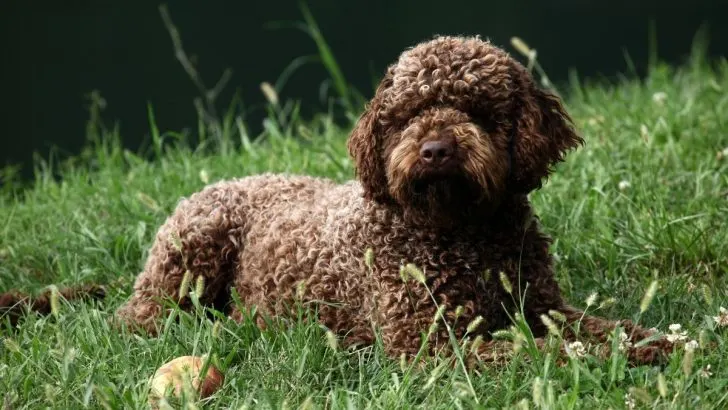Lagotto Romagnolo colors are truly a delightful part of this charming breed. Their coats can range from rich chocolate browns to creamy whites, making each Lagotto uniquely beautiful.
Now, imagine a fluffy pup whose coat can change shades as it grows, revealing warm earthy tones, striking white patches, or playful orange roan spots. Oh, so lovely!
These vibrant colors make every Lagotto Romagnolo a one-of-a-kind companion.
Let’s dive into each and every color of this remarkable breed and discover what makes their coats so special.
7 Standard Lagotto Romagnolo Colors
The Lagotto Romagnolo, often referred to as the Italian Water Dog, is a breed known for its affectionate nature, intelligence, and exceptional truffle-hunting abilities.
Now, this working breed is not just loved for its skills and temperament but also for its unique and varied coat colors.
In dog shows and competitions, Lagotto Romagnolo dogs are judged based on how closely they adhere to their breed standards, including coat color.
So, if you want to join these events, the color of a Lagotto must be within the standard. Here are the different shades accepted by the American Kennel Club (AKC) and the Lagotto Romagnolo Club of America (LRCA). .
1. Off-White
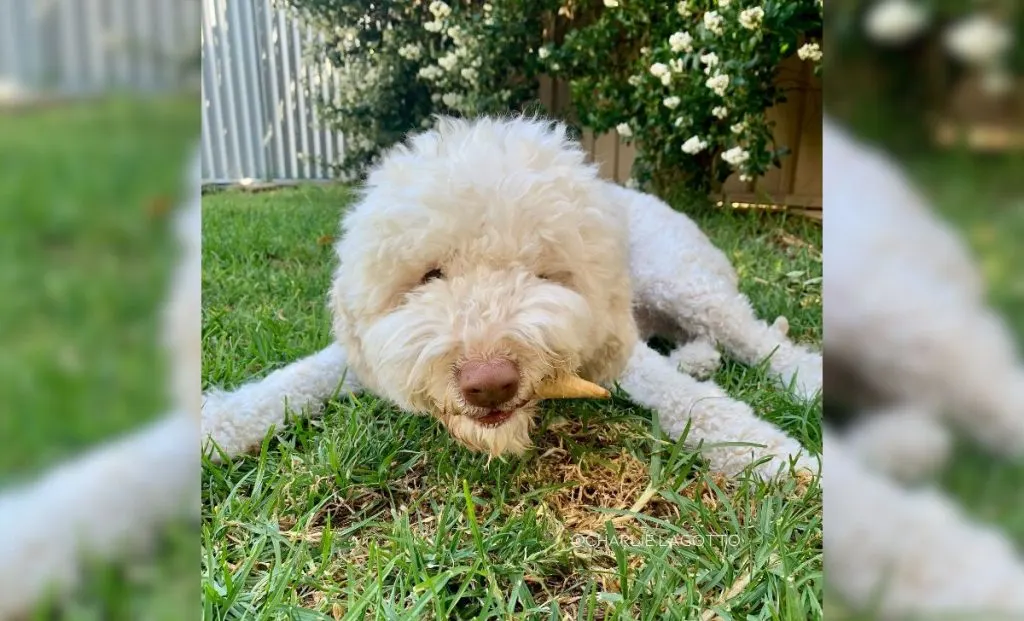
An off-white Lagotto Romagnolo sports a coat that ranges from cream to ivory tones. Many people might mistake this Lagotto for one with white fur. But here’s the thing.
This color provides a softer, more muted appearance compared to the simplicity of a pure white coat.
Apart from that, the off-white hue can vary in intensity, often appearing as a light beige or pale yellowish-white, giving the dog a warm, gentle look.
So, we like to call them ”almost white dogs”. Oh and, they inherit the cutest light brown noses!
The off-white coloration in Lagotto Romagnolos is typically the result of a lighter expression of the genes responsible for the white coat.
This means that while the dog genetically has a white coat, the pigmentation is slightly diluted, leading to an off-white appearance.
Such color is seen in several other dog breeds like Labrador Retrievers, Great Pyrenees, and Bichon Frise.
2. Brown Roan
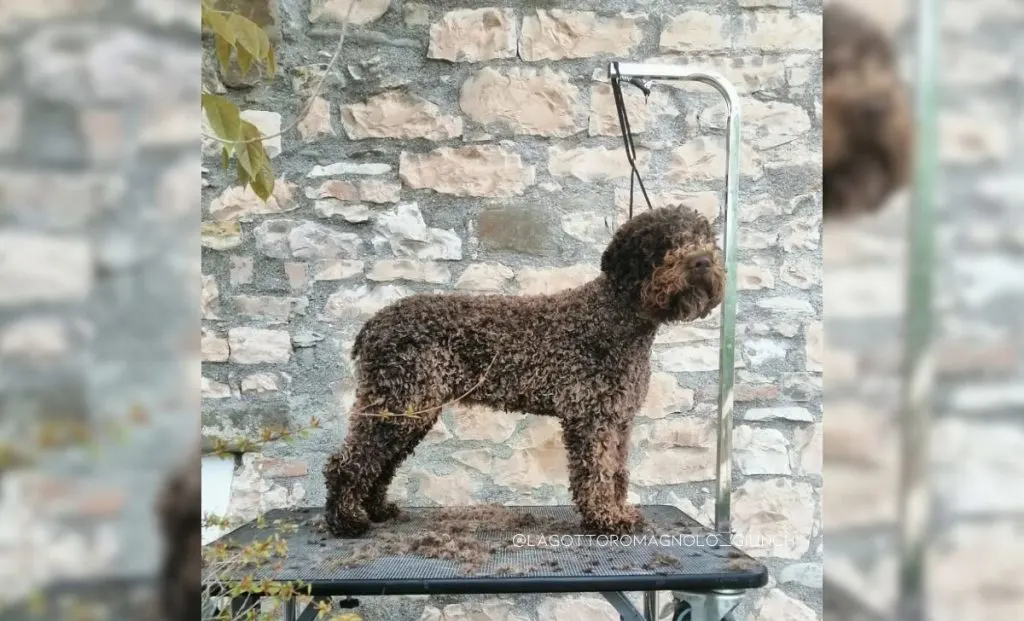
Now, a brown roan Lagotto is one of those you see immediately when you google this breed.
The brown roan is a very interesting color in a Lagotto Romagnolo that is characterized by a mix of brown and white hairs, creating a mottled or speckled appearance. This is due to them carrying a ticking gene.
Sounds familiar? Maybe you have seen this pattern in the well-known German Shorthaired Pointer breed.
This coat pattern gives the dog a textured and unique look, as the blend of colors can vary in intensity and distribution across the coat.
To be more precise, the brown parts of the coat are interspersed with white, which results in an evenly blended coloration. In fact, the brown areas are noticeable in Lagotto puppies as young as
Depending on the marking and spotting, some breeders categorize brown roan Lagotto Romagnolos into Brown Roan 1, with beige white parts freckled with brown spots, and Brown Roan 2, featuring various shades of brown with white hairs dispersed throughout the body.
In brown roan Lagotto Romagnolos, the nose and paw pads are typically brown. The intensity of the brown can vary but generally matches the brown hues found in the coat.
This consistent coloration extends to other pigmented areas, such as the lips and eye rims.
3. Brown
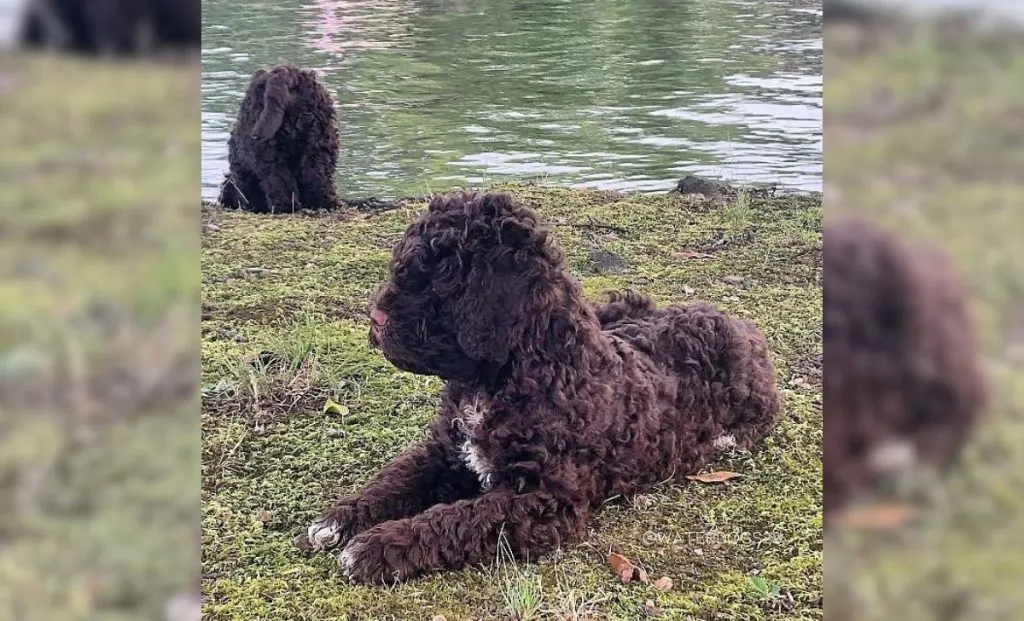
Brown Lagotto puppies are often born with a dark brown coat, which may lighten slightly over time but remains predominantly brown throughout their lives.
Over time, these brown dogs sport some white hairs that may intermingle and create a slightly lighter or variegated appearance.
The solid brown coat can range from dark brown to lighter brown as the dog matures.
The adorable eyes of a Lagotto are typically a deep chocolate color, which really complements the brown coat and adds to their endearing looks.
The nose and paw pads of these brown puppies are usually brown, matching the coat color.
4. Orange
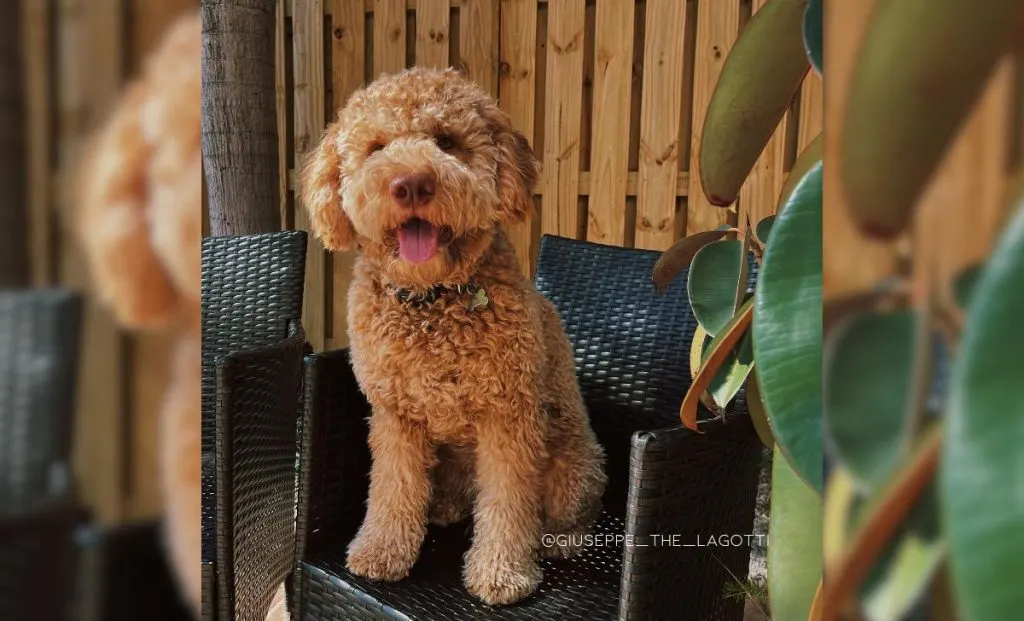
Orange puppies will typically have some orange show during the first weeks of life. As they grow, this color may fade to a lighter, creamier apricot color.
This transformation can begin within the first 8 to 20 weeks and may continue to lighten over time.
Let’s look into the genetic rules and the gene pool of the color orange. Here, the agouti signaling protein (ASIP) gene plays a role in coat color by regulating the distribution of yellow and black pigments.
Variants in this gene can lead to a wide range of different color patterns, including orange, depending on how they interact with other coat color genes (1).
The orange coloration in Lagotto Romagnolos is thought to have been introduced through early crossbreeding with other water dogs.
Some orange Lagottos may have white spots on their coat. These spots are typically small and scattered. On the other side, some may have orange spots on an off-white coat.
5. White
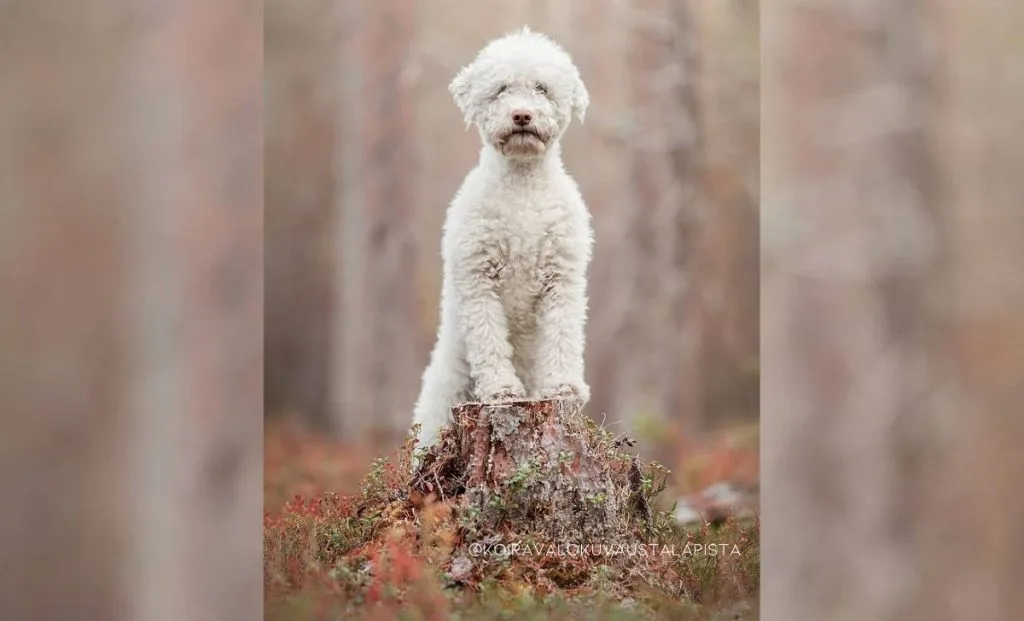
Moving on to the white Lagotto Romagnolo. This a striking and elegant variation of this breed, known for its predominantly white coat.
While these dogs may appear entirely white as puppies, their coats can sometimes change slightly as they mature.
This color is different from off-white, which includes shades of cream and ivory. White Lagottos maintain a pure white coat throughout their lives, whereas off-white Lagottos can display a range of lighter hues.
Young dogs may occasionally have small brown or black markings (flecks), known as birth markings, which typically disappear within a few weeks underneath their first hair.
The thing about these white puppies is that they can either stay white or turn towards the apricot color as they mature.
In line with the breed standard, white Lagottos have a brown nose and paw pads.
6. Sable
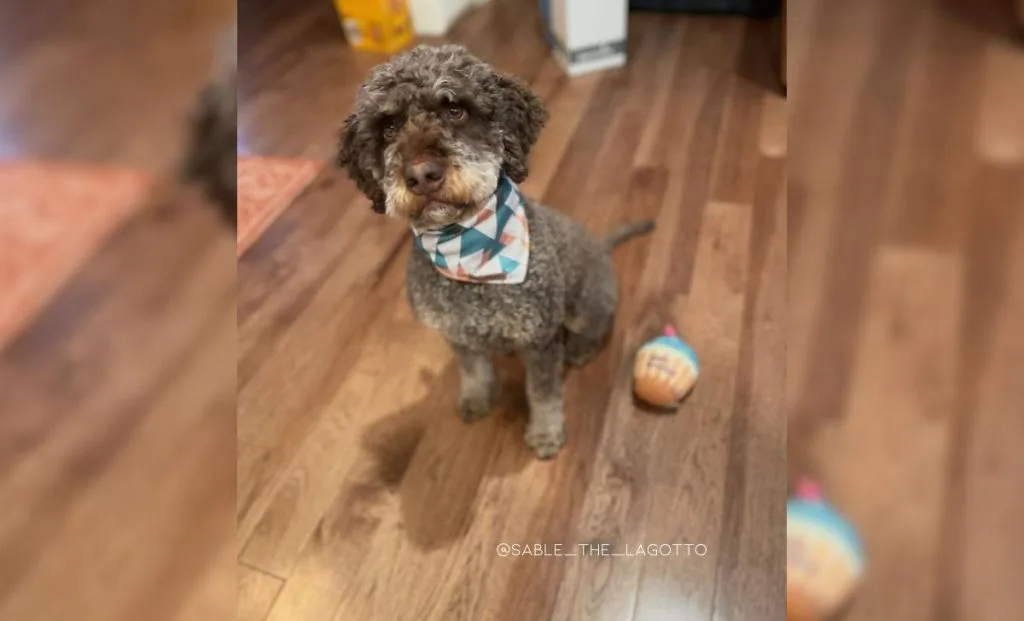
The sable coat color of a Lagotto Romagnolo features a lighter base, often cream or tan, with darker tips, creating a beautiful shaded effect.
If you fancy some genetic rules and talks, here is how to best describe it.
The sable color is the result of several genes working together. The dominant E allele at the E locus allows for the expression of the sable pattern, controlled by the A^y allele at the A locus. The expression of genes K (K locus) also plays a role, where the recessive k allele permits the sable pattern to show.
This combination of genes results in the pawesome appearance of a sable Lagotto. It features consistent brown pigmentation on the nose and paw pads.
7. Orange Roan
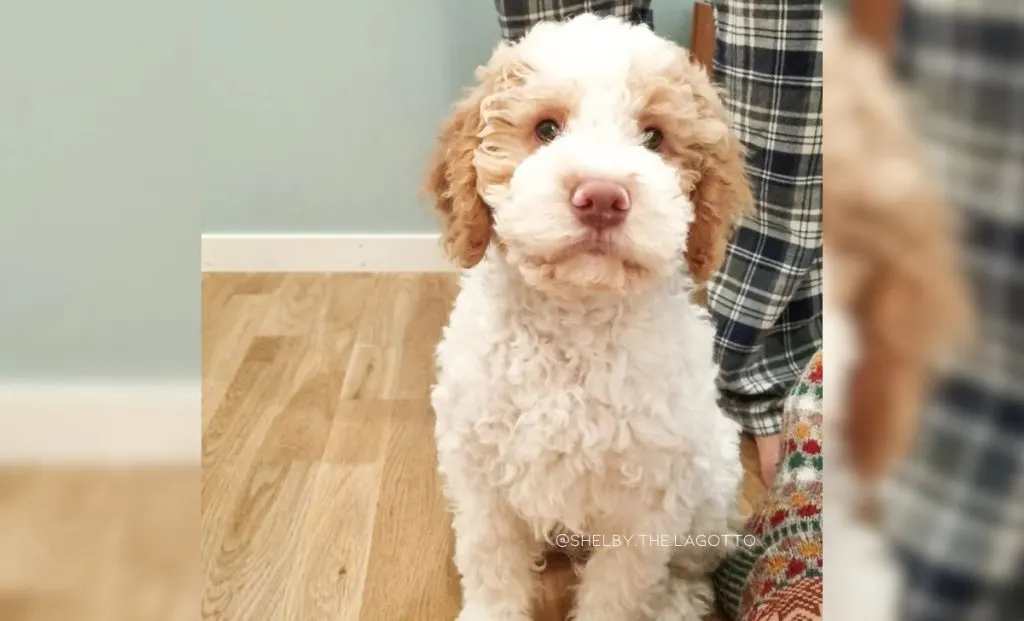
The orange roan Lagotto Romagnolo is truly a unique one!
This pup is characterized by a blend of orange and white fur that complement each other to the fullest.
The coat has a roan pattern, where the white fur is interspersed with orange hairs, giving it a speckled or mottled appearance.
This coloration is the result of specific genetic interactions that lead to such a pattern. The coat is curly and dense, typical of the Lagotto Romagnolo breed, and the orange roan pattern extends uniformly across the body.
The orange roan color can range from a bright, vibrant orange to a more subdued, creamy apricot shade as the dog matures.
Not many dog breeds inherit this unique coat color. In fact, aside from Lagottos, orange roan can be found in English Cocker Spaniels and English Springer Spaniels.
Lagotto Romagnolo Markings And Patterns
Lagotto Romagnolos are known for their curly coats, long legs, truffle-hunting abilities, and variety of colors. But hey, they are also known for their striking markings and patterns!
Let’s say a few things about the different types of markings and patterns you might find on these cuties.
1. White Markings
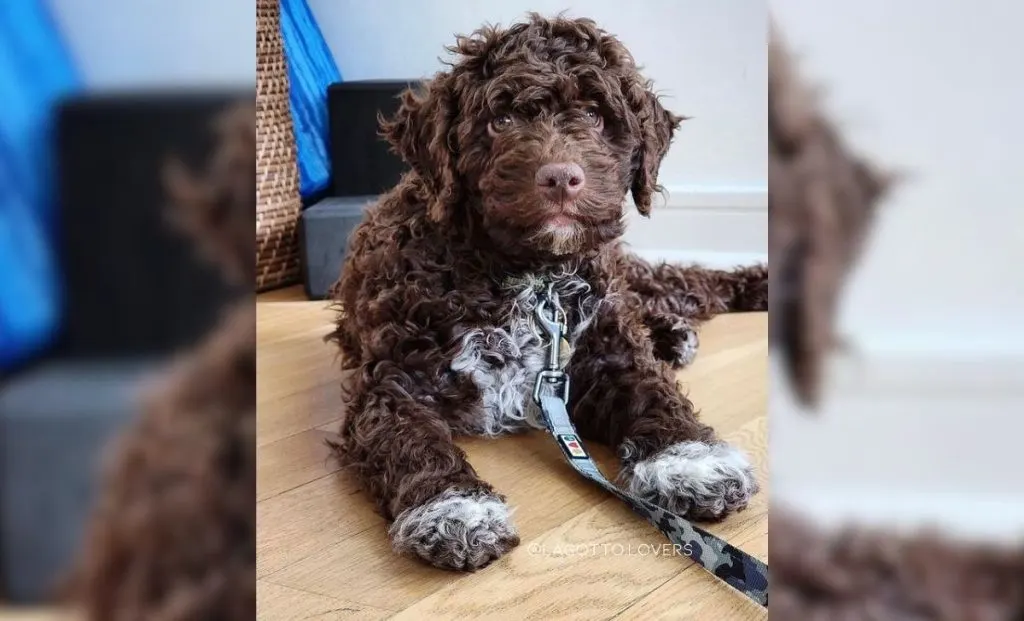
White markings can appear in many places on a Lagotto Romagnolo dog.
You might see them on the chest, paws, or even (rarely) as a blaze on the face.
A broad white patch or a smaller spot can adorn the chest, standing out prominently against darker fur.
White socks or tips on the paws can give the appearance of the dog wearing white gloves or boots.
Some Lagottos may even have a white tip on their tails!
A blaze is a white stripe running up the center of the face, similar to what you might see on breeds like Border Collies, Australian Shepherds or Boxers.
The size and shape of these white markings can vary, so no two Lagottos are exactly alike.
2. Brown Markings
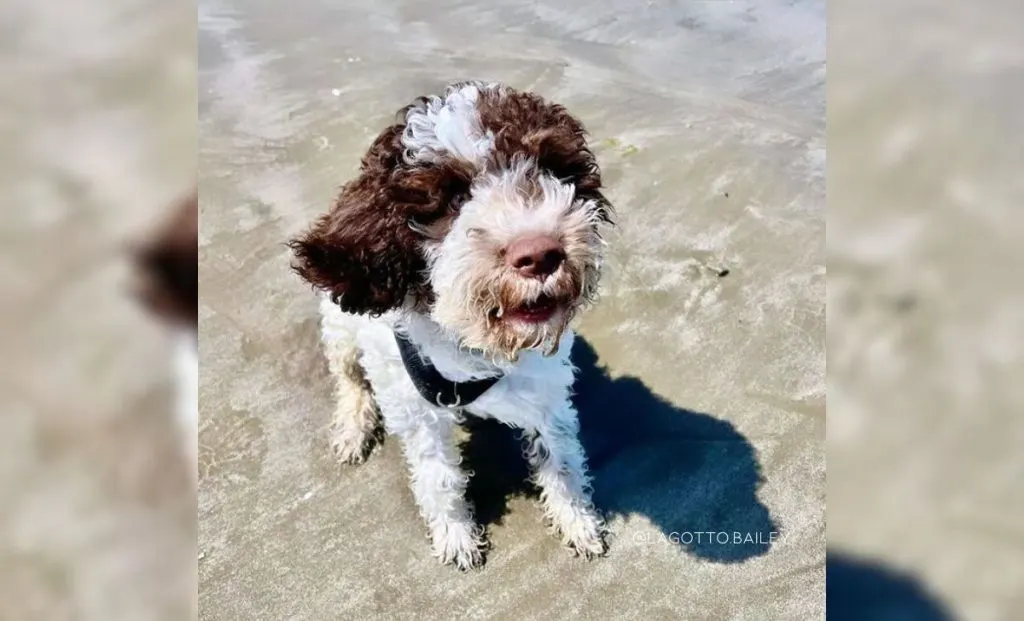
Brown markings in Lagottos can range from deep, rich chocolate to lighter milk-chocolate shades. These markings can cover larger areas or appear as smaller patches.
For example, larger patches of brown color can cover significant areas of the dog’s body, blending with other colors or standing alone.
Brown spots or patches on their long legs can vary in size and shape. They can be big or small, across both legs or just on the shoulders or paws.
Additionally, Lagottos can inherit brown ears against a lighter face which can create a very special look.
Brown markings can also be present around the eyes and on the face.
3. Orange Markings
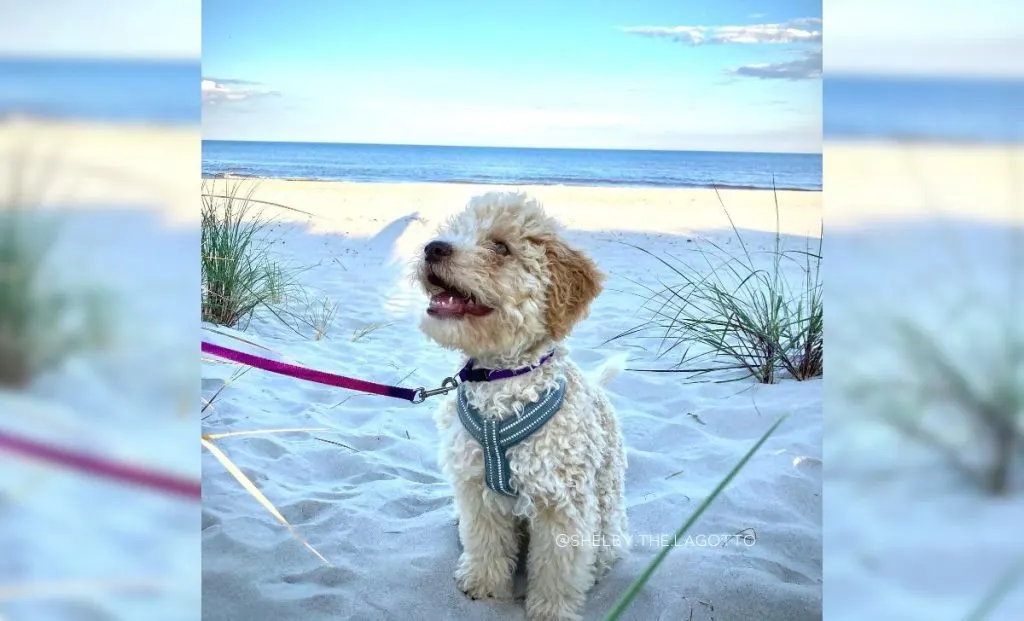
Orange markings are less common but very impressive. They can range from a light apricot color to a deeper, more vivid orange.
You might see these markings on the ears, around the eyes, or on the body.
For instance, some Lagotto Romagnolo pups can have orange ears against a white or lighter face.
Orange markings can be found around the eyes or on the muzzle too. They can also be common on the legs and paws of the Lagotto dog.
4. Tan Markings
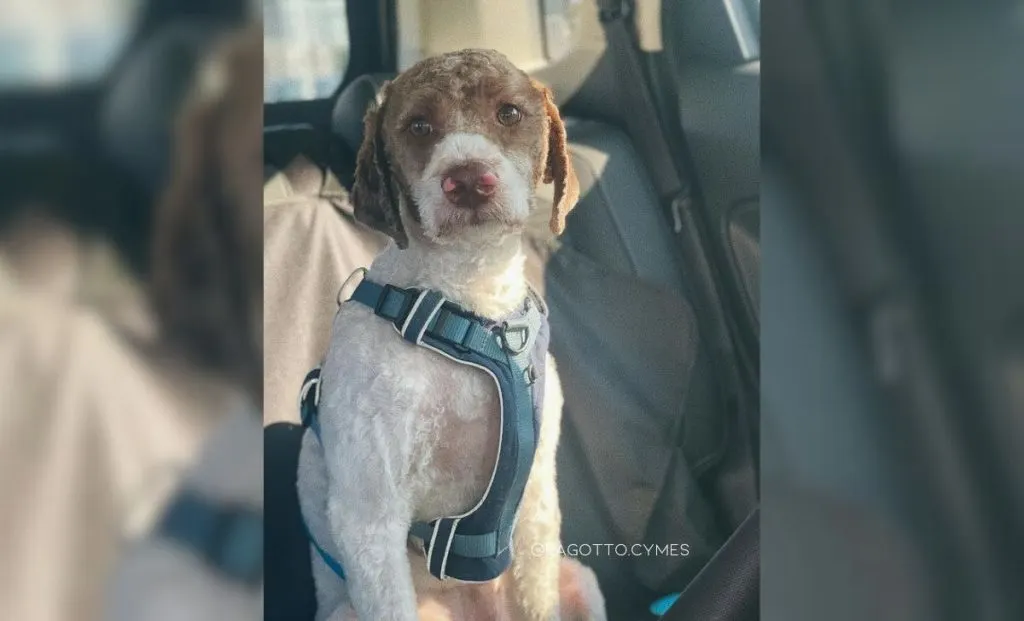
Tan markings are another lovely feature you might see in this remarkable breed.
These markings can be found on the legs, face, and chest. The tan color can vary from a pale beige to a deeper caramel tone.
Breeds such as the German Shepherd, Rottweiler, and Beagle commonly have tan markings.
These markings blend beautifully with the base color of the coat and give this doggo a balanced but harmonious look.
5. Roan Pattern
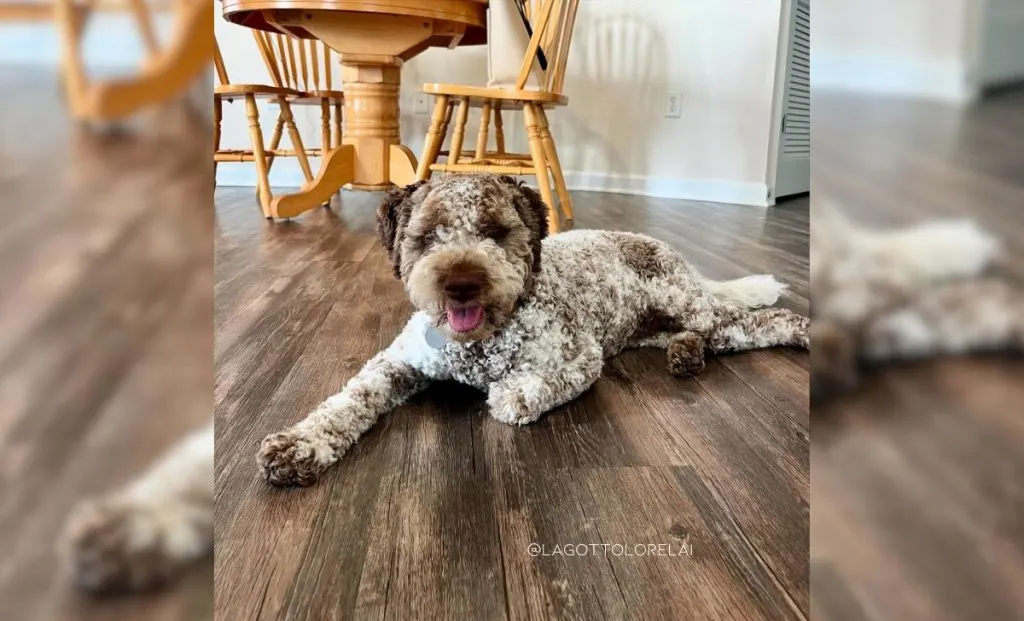
We’ve already given you a scoop on roan patterns, but it is worth mentioning it again on its own.
The roan pattern is a mix of white and colored hairs which gives the coat a mottled appearance. In the Lagotto Romagnolo breed, you can find roan patterns in various colors, like brown roan, orange roan, and even black roan.
Now, the entire coat of a Lagotto can have a speckled, roan appearance. Specific areas, such as the back or sides, can show more intense roaning.
Roan patterns on the legs can vary, with some areas more densely roaned than others.
As you can see, this pattern adds depth and texture to the coat, making it look almost speckled.
6. Patchy Pattern
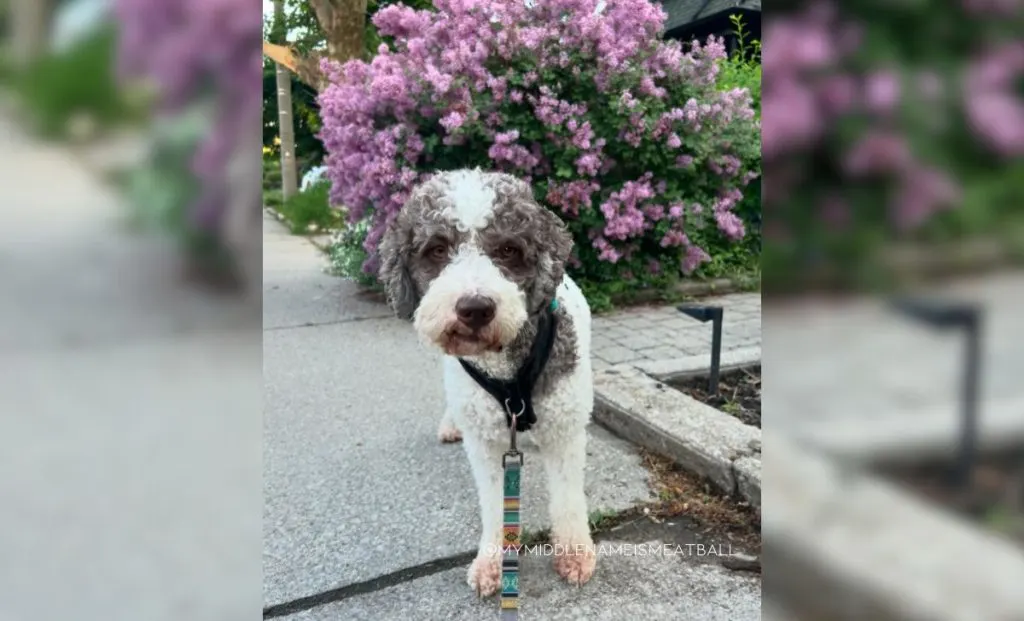
Patchy or parti-color patterns consist of large patches of two or more colors. These patches can be distributed randomly or symmetrically across the dog’s body.
Large, irregular patches of different colors can be scattered across the body. Patches on the face can be present as well, with contrasting colors highlighting the eyes and muzzle.
Similar to other markings, patchy patterns on the legs can vary in size and shape, but appear anywhere on the body.
Ears, on the other hand, may be a different color from the rest of the face.
Breeds like the English Springer Spaniel, Papillon, and Poodles often exhibit striking patchy patterns.
What Is The Rarest Color Of Lagotto Romagnolo?
While Lagotto Romagnolos come in plenty of beautiful colors and patterns, some colors are rarer than others. Two of the rarest colors you might encounter are solid black and albino.
And no, they are not recognized by the American Kennel Club nor any other or new clubs.
1. Solid Black
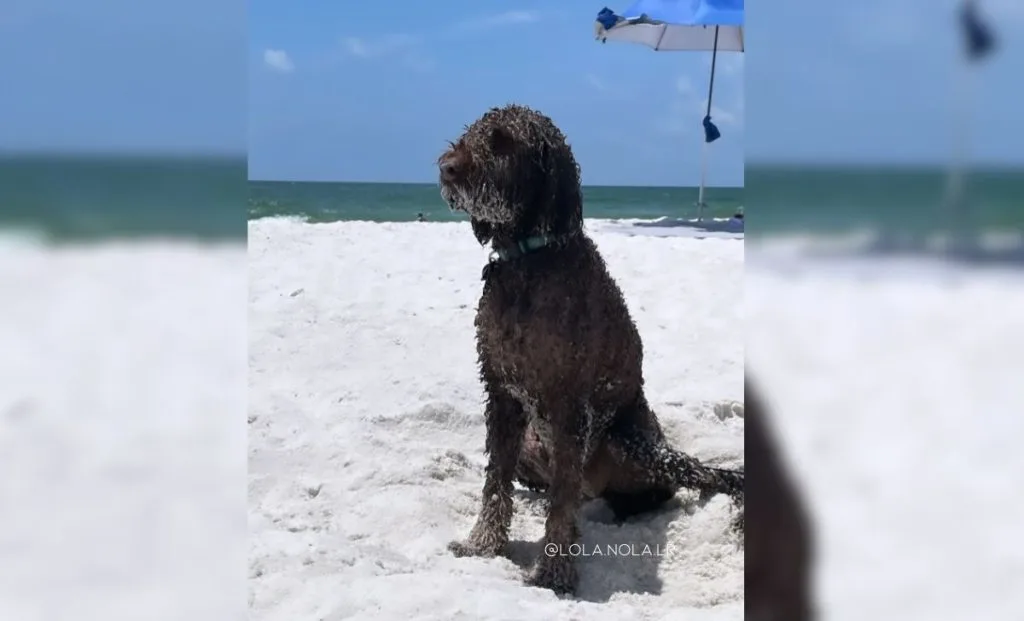
A solid black Lagotto Romagnolo is extremely rare, and the color black is an unwanted trait in show dogs.
Most black Lagottos have some white markings or other color variations mixed in, making a truly solid black coat uncommon.
This color can give the dog a sleek, striking appearance, but finding a Lagotto with an entirely black coat without any white patches is unusual.
Breeders might occasionally come across solid black puppies, but they are not the norm in this breed, as Lagottos should never have any black pigmentation.
2. Albino
Albino Lagotto Romagnolos are even rarer than solid black ones.
Albinism is characterized by a complete lack of pigmentation, resulting in a white or pale coat, pink skin, and light-colored eyes, often blue or pinkish.
Albino dogs are, therefore, sensitive to sunlight and can have health issues related to their lack of pigmentation.
This condition is exceedingly rare in Lagottos, making albino individuals very unique.
However, albino Lagottos are not typically sought after for breeding due to the health complications associated with albinism.
While these rare colors can make a Lagotto Romagnolo look very unique, they are not commonly seen within the breed.
Most of the purebred pups will have the more typical coat colors and patterns, such as white, brown, orange, tan, roan, or patchy patterns.
Do Lagottos Change Color?
Yes, Lagotto Romagnolos can change color as they mature.
Lagotto Romagnolo puppies often have a different coat color than they will as adults.
For instance, a puppy born with a dark brown coat might lighten to a lighter shade of brown, cream, or even develop roan patterns as they grow. Roan patterns, in particular, tend to become more pronounced with age.
Senior Lagottos may experience a lightening or fading of their coat color – getting a few grays here and there. This contrast is especially common in dogs with darker colors like brown or black.
Lagotto Romagnolo colors can also change slightly with the seasons. Some dogs may have a coat that appears darker or lighter depending on the time of year.
So, that’s about it.
But hey, while Lagotto Romagnolo colors are dynamic and can change throughout their life, their loving and loyal personality remains constant.
References
D. Bannasch et al. “Dog colour patterns explained by modular promoters of ancient canid origin.” Nature Ecology & Evolution, 5 (2020): 1415 – 1423. https://doi.org/10.1038/s41559-021-01524-x.

Meet Iram, a devoted veterinarian, passionate dog lover, and current Ph.D. candidate at Utrecht University in the Netherlands. Seamlessly blending her roles as a vet and content writer, Iram channels her love for dogs into heartfelt narratives.
Since childhood, Iram nurtured a dream of becoming a vet, a passion that runs deep in her family. Having now fulfilled that dream, she’s eager to share her acquired knowledge. In her writing, Iram not only explores the emotional bond between humans and their canine friends but also integrates her veterinary expertise, offering readers a holistic understanding of their beloved pets.
